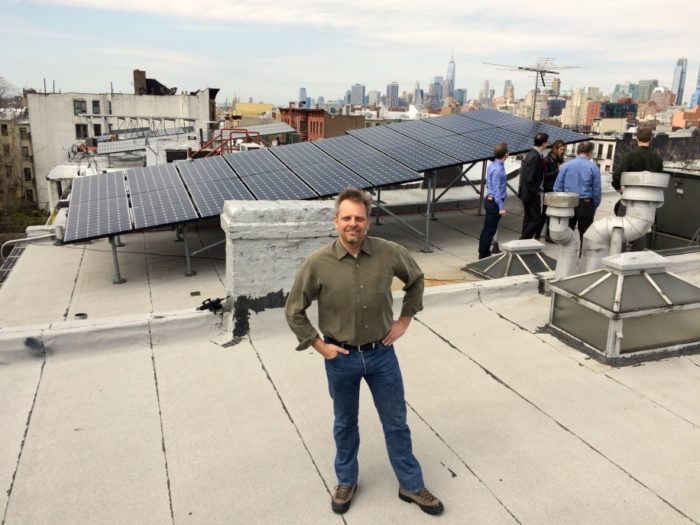
A network of small photovoltaic (PV) arrays linked together in a Brooklyn, New York, neighborhood will soon allow homeowners and small businesses to buy and sell energy from each other directly, and potentially provide energy to connected members should the grid fail in a catastrophic storm.
The project, called the Brooklyn Microgrid, is the work of L03 Energy, a New York startup, along with the German technology giant Siemens and a Siemens financial subsidiary. So far, some 50 participants are connected through blockchain cryptographic software that allows direct energy sales, according to an article posted by Siemens.
Neighbors with and without photovoltaic systems can participate using the blockchain platform, which securely documents each transaction as it occurs. It’s the same type of software powering Bitcoin currency transactions. (The New York Times explains the web-based technology in this story.)
Developers see the fledgling Brooklyn Microgrid as a way for both residential and business members who have solar arrays to sell excess power directly to their neighbors without the intervention of a conventional electricity supplier. People without PV arrays of their own will be able to buy energy, much as they can purchase “green” power now from their utility. Developers are signing up both homeowners and business owners in an affluent part of the borough called Gowanus and Park Slope, The Times reported.
“Peer-to-peer is slowly but surely becoming a reality,” Olaf Lohr, head of U.S. business development for Germany’s Sonnen, told the newspaper. “This really is a very disruptive technology. The customers are also the owners — they are the producers of the energy. There is no centralized feed-in from one big power plant.”
Still grid-connected in Brooklyn
In New York, energy providers are being pushed to become more flexible under a program called Reforming the Energy Vision (REV). Small groups of consumers who also produce electricity would be part of a reshaped electric grid, making the flow of energy more responsive to consumer needs. In the event of a crippling storm such as Hurricane Sandy in 2012, microgrids would offer its members a way of keeping the power on even when the grid failed.
In Brooklyn, there are more regulatory hurdles to clear before energy can actually be bought and sold, but L03 tested the idea with the sale of renewable-energy credits last year. The Times reported that the Brooklyn Microgrid is designed to stay connected to the conventional electric grid; even when energy sales are allowed to move forward, participants would continue to pay Con Edison service fees designed to cover the cost of maintaining poles, wires, and other parts of the distribution system.
Those who sign up for the microgrid, however, would have a great deal of flexibility on where their power comes from and be able to use a smartphone app to control purchases.
According to an article at Utility Dive, transactions on L03’s TransActive Grid peer-to-peer trading platform are tamper-proof. Blockchain technology has potential uses across many industries, not just energy.
In an article last year, Fast Company said there were three big advantages to microgrids based on blockchain technology: energy could be transported over shorter distances, minimizing losses; payments received for energy sales stay in the community, rather than “padding some dividend check”; and communities become more resilient because they can be disconnected from the grid during destructive storms.
“In the world of finance, blockchain technology is rapidly advancing across many sectors, but in the energy market, things are comparatively different,” Orsini said in a statement at Business Wire. “With our microgrid solution in Brooklyn, we’ll demonstrate just the beginning of what blockchain can do in the transactive energy world.”
Weekly Newsletter
Get building science and energy efficiency advice, plus special offers, in your inbox.














0 Comments
Log in or create an account to post a comment.
Sign up Log in